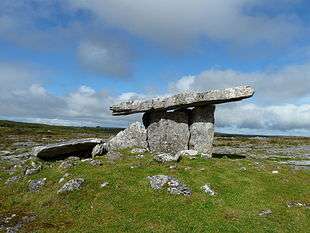Poulnabrone dolmen
| Poll na mBrón | |
 Poulnabrone | |
 Shown within Ireland | |
| Location | parish of Kilcorney, the Burren |
|---|---|
| Region | Ireland |
| Coordinates | 53°02′56″N 9°08′24″W / 53.048842°N 9.139953°W |
| Type | Portal tomb |
| History | |
| Periods | Neolithic |
| Site notes | |
| Excavation dates | 1986, 1988 |
| Public access | Yes |
| Reference no. | 632[1] |
Poulnabrone dolmen (Poll na mBrón in Irish, meaning "hole of the quern stones" (bró in Irish)) is a portal tomb - one of approximately 174 in Ireland - located in the Burren, County Clare, Ireland. It dates back to the Neolithic period, probably between 4200 BC and 2900 BC. It is situated 8 km (5 miles) south of Ballyvaughan, 9.6 km (6 miles) north-west of Kilnaboy.[2]
Location
The tomb is located in a rocky field in the townland of Poulnabrone, parish of Kilcorney, close to the R480 road, south of Ballyvaughan in County Clare.
Name
Poulnabrone is sometimes wrongly translated as "Hole of Sorrows" (e.g. on Google Maps). However, "brone" is derived form the Irish bró, meaning quern.[3]:31
Features

The dolmen consists of a twelve-foot, thin, slab-like, tabular capstone (horizontal) supported by two sets of slender upright (vertical) parallel portal stones, which support the capstone 1.8 m (6 ft) from the ground, creating a chamber in a 9 m (30 ft) low cairn. The cairn helped stabilize the tomb chamber, and would have been no higher during the Neolithic. The entrance faces north and is crossed by a low sill stone.[2]
Excavations

A crack was discovered in the eastern portal stone in 1985. Following the resulting collapse, the dolmen was dismantled, and the cracked stone was replaced. Excavations during that time (1986, 1988) found that 33 people, both adults and children, were buried under the monument. Personal items buried with the dead included a polished stone axe, a bone pendant, quartz crystals, weapons and pottery.[4]:136
There were no intact skeletons, indicating the site was not used as a burial place in the sense that bodies were placed there immediately after or even close to the time of death. Bones were found in the original strata, but jumbled chronologically, so they were not buried sequentially. Only one of the adults seems to have lived past 40 and many of the bones showed signs of arthritis in the upper body. The children had teeth showing signs of illness and malnutrition. Two of the bodies displayed injuries: A skull and rib cage with depressed fractures, healed before death and an adult male hip bone, pierced by the tip of a stone projectile and not healed, which means the injury occurred not much before the time of death. Those selected for deposit at this site were apparently the members of some sort of elite. Their bodies were left elsewhere to decompose, in a protected location, as none of the bones show any signs of teeth marks. Only the bare bones were then taken here and deposited. As some of them show scorch marks, they may have been ritually purified by fire beforehand.[4]:136-8
According to Radiocarbon dating, the tomb was likely used between 3,800 and 3,200 BC. The findings are now at the Clare Museum, Ennis, loaned from the National Museum of Ireland.[5][4]:136
In the Bronze Age, (c. 1750 to 1420 BC), a newborn baby was buried in the portico, just outside the entrance.[4]:138
With its dominating presence on the limestone landscape of the Burren, the tomb was probably a centre for ceremony and ritual until well into the Bronze Age period. It may have also served as a territorial marker in the Neolithic landscape on the important north-south route from Ballyvaughan bay to Kilnaboy. It is possible that the inhabitants of extensive settlements near Kilnaboy erected the structure to delimit the northern border of their territory.[4]:138
Tourism
The dolmen is a popular tourist attraction, located close to the road between Ballyvaughan and Kilnaboy. A rope provides a barrier between tourists and the dolmen in order to preserve the ancient stone. It is requested that tourists do not go beyond this barrier or touch the dolmen. A large car park was opened in 2007 by the Clare County Council to deal with traffic problems caused by cars or coaches parked in the narrow road. A 2005 estimate put the number of annual visitors at 200,000.[6]
Astronomy
Due to the Burren's lack of light pollution and Poulnabrone's remote location, the car park has been used by Shannonside Astronomy Club[7] as an unofficial public observatory. In April 2013, many observations of the comet PanSTARRS C/2011 L4 were made by the club at this location.
Gallery
References
- ↑ National Monuments in County Clare
- 1 2 Weir, A (1980). Early Ireland. A Field Guide. Belfast: Blackstaff Press. p. 110.
- ↑ Cunningham, George (1978). Burren Journey. Shannonside Mid Western Regional Tourism Organisation.
- 1 2 3 4 5 Carthy, Hugh (2011). Burren Archaeology. The Collins Press. ISBN 9781848891050.
- ↑ "Poulnabrone Collection". Retrieved 7 February 2015.
- ↑ "Poulnabrone Dolmen Car Park - Traffic Management". Retrieved 7 February 2015.
- ↑ "Shannonside Astronomy Club". Retrieved 10 April 2013.
- Ann Lynch, Jessica Beckett: Poulnabrone: An Early Neolithic Portal Tomb in Ireland, 2014, ISBN 9781406428179.
External links
- Poulnabrone at the Clare County Library website
- The History of Poulnabrone on the Irish Archaeology website
| Wikimedia Commons has media related to Poulnabrone. |
Coordinates: 53°2′55.83″N 9°8′23.83″W / 53.0488417°N 9.1399528°W




.jpg)